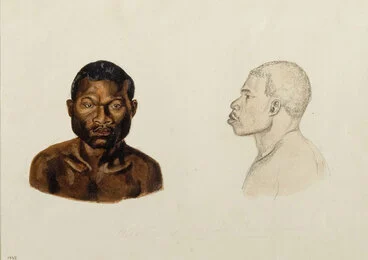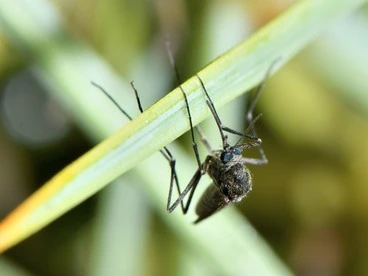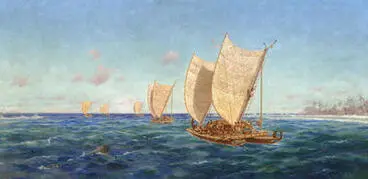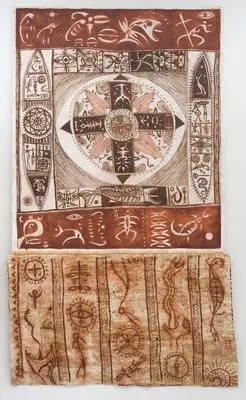Pacific Migration And Settlement
A DigitalNZ Story by National Library Services to Schools
Resilient groups of people from Southeast Asia were the first explorers of the planet's largest ocean, the Pacific. They were able to locate thousands of tiny islands and atolls and not only survive, but establish vibrant communities.
BACKGROUND
The world’s first seafarers set off from South-East Asia, sailing into the Pacific on simple rafts. Thousands of years later their Polynesian descendants began exploring further east, guided by the stars and the winds. How did they survive these journeys into the unknown? And when did they discover New Zealand, the final major land mass to be settled? Radiocarbon dating and computer voyaging have provided a wealth of insights.
Source: Pacific migrations, Te Ara - the Encyclopedia of New Zealand
These truly maritime people developed sophisticated ocean sailing technology several thousands of years ahead of the Vikings and other western civilisations. So skilled were they in not only navigation but the necessities of survival in the unique and challenging environment of the Pacific Ocean, that they were able to settle the last uninhabited landmasses on Earth. This was particularly remarkable, as all other parts of the world had been reached and settled by simply walking.
CONTENTS
- Asia to Near Oceania
- Near Oceania to Remote Oceania
- Lapita technology
- Remote Oceania to Hawaii, Rapa Nui & Aotearoa
- Sail technology
- Navigation techniques
- Polynesian navigators
- Tonga-Samoa-Fiji Trade
- Glossary
- Supporting resources.
Settlement of the Pacific via Southeast Asia.
Manatū Taonga, the Ministry for Culture and Heritage
ASIA TO NEAR OCEANIA (50,000 TO 25,000 BCE)
During the last Ice Age, 60,000 years ago, the sea was approximately 60 m below its current level. People moved south through central Asia towards the coast, an area formally known as Sunda, that encompassed most of the archipelagoes of Southeast Asia, then dry land. They reached the western Pacific Ocean and successfully crossed the gap estimated at 90 km between Sunda and Sahul (Australia, New Guinea and Tasmania, then joined by land bridges). It is most likely they accomplished this on simple bamboo or log rafts.
Over this period, these people managed to travel as far as Melanesia into what has been called Near Oceania and included New Guinea, the Bismarck Archipelago, the Admiralty Islands and the Solomon Islands.
They had Paleothilic (stone-age) technology and were predominantly hunter-gatherers. They were also highly resourceful and able to quickly adapt skills and technologies to new environments as well as develop sophisticated language and artistic abilities.
An example of a Torres Strait bamboo raft.
Manatū Taonga, the Ministry for Culture and Heritage
QUICK FACTS
- The bones of several species of wild animals introduced by humans have been found on islands in the Pacific, including the cuscus, the northern pademelon, the bandicoot and the black dorcopsis wallaby, all small marsupials.
- Trade between island groups was already occurring at this stage. Stone was particularly valuable, especially obsidian. It was used for scoring bone tools, creating spear tips and tattooing.
- Wild food plants were available, most commonly sago, banana, yam and taro. Stone hatchets with traces of plant material on them have been found on these islands suggesting that people had tended the wild plants - the beginnings of plant cultivation.
Obsidian
Museum of New Zealand Te Papa Tongarewa
basket
Auckland War Memorial Museum Tāmaki Paenga Hira
NEAR OCEANIA TO REMOTE OCEANIA (1,100 BCE)
Moving further east, into what is known as Remote Oceania (Vanuatu, New Caledonia, Fiji, Tonga and Samoa), was problematic as the islands became more scattered, smaller and in some instances, less habitable.
However, with the arrival in Near Oceania of people known as the Lapita, also from Southeast Asia, things changed. The Lapita were named for the distinctive pottery they made that has been found in many sites on islands in the Pacific. For a time it is thought that the original settlers of Near Oceania and the Lapita lived together; these people were the ancestors of Polynesians and Māori.
QUICK FACTS
- There is evidence that several food plants were transported on canoes and introduced to new islands. Among these were breadfruit and the canarium almond, which was also used for adornment.
- Domesticated animals were also introduced, including pigs, dogs, chickens and rats; we can be certain these species were introduced as none of these animals could have crossed the large bodies of water required to reach these islands on their own.
- Seafood, an important food source on these more remote islands, was caught using a variety of nets, traps, spears and hooks.
- It is thought that several species of animal became extinct quickly after the arrival of humans, including a land based crocodile, giant iguana and flightless birds.
- When these people left Near Oceania, the deadly disease malaria, carried by mosquito, did not go with them.
Fijian man carrying breadfruit
Museum of New Zealand Te Papa Tongarewa
Saltpool Mosquito
iNaturalist NZ — Mātaki Taiao
LAPITA TECHNOLOGY
The pottery of the Lapita people was similar in form to their forebears, but the decorative style was an innovation that emerged in the Bismarck Islands. The design included stylised faces, which were most elaborate during the early years of the migration and clearly carried cultural significance. This unique style was one of several traits referred to as the ‘Lapita cultural complex’.
Source: Pacific migrations - Into Remote Oceania: Lapita people, Te Ara - the Encyclopedia of New Zealand
Shards of the distinctive Lapita pottery found in New Caledonia.
Manatū Taonga, the Ministry for Culture and Heritage
QUICK FACTS
Lapita people left behind clues to their way of life, including their distinctive finely decorated pottery. Archaeologists have also found:
- plain, undecorated pottery
- stone and shell adzes
- flake tools made of obsidian and chert
- knives and scrapers made from shell
- sling stones
- shell rings, bracelets and armbands
- needles, awls and tattooing chisels made from shell
- fishhooks and sinkers.
Sites of Lapita pottery
Manatū Taonga, the Ministry for Culture and Heritage
ring
Auckland War Memorial Museum Tāmaki Paenga Hira
REMOTE OCEANIA TO HAWAII, RAPA NUI & AOTEAROA (1,300 CE)
The last islands to be settled were those at the limits of the Pacific region, Hawaii, Rapa nui (Easter Island) and Aotearoa.
This migration did not occur immediately after settlement of Remote Oceania, in fact, scientific investigations suggest that it took 1,000 years. This has become known as The Long Pause.
It is not known what eventually allowed further exploration, however, it is possible that perfecting the use of technologies for constructing canoes as well as accumulated knowledge and skills in navigation, had an impact. Changes in the direction of trade winds and ocean currents may have also played a part. It is likely that many voyages of exploration would have taken place prior to permanent settlement.
Kupe was a legendary Pacific explorer.
Manatū Taonga, the Ministry for Culture and Heritage
QUICK FACTS
- Waka hourua, double-hulled canoes with sails, are believed to have been the means by which these last remaining islands were settled.
- The people that settled on these three island groups developed highly distinctive cultures due to their isolation from other Pacific islands. For example, Rapa nui is well known for its moai, giant stone statues, that are not found anywhere else in the Pacific.
- According to Māori narratives, Kupe is believed to have been the first pacific explorer to reach Aotearoa.
- The kuri (Pacific Dog) travelled with the voyagers and was a valuable possession as a food source as well as for its skin, fur and teeth that were used for cloaks and ornamentation for high ranking people.
- This dog may have shared some DNA with the Australian dingo and in Hawaii, it was known as the ilio or Hawaiin Poi Dog. There is no evidence that this species made it to Rapa nui.
Ten canoes leave Rarotonga
Manatū Taonga, the Ministry for Culture and Heritage
Waka hourua 'Te Aurere Iti' (model voyaging canoe)
Museum of New Zealand Te Papa Tongarewa
Kurī
Manatū Taonga, the Ministry for Culture and Heritage
SAIL TECHNOLOGY
The development of the sail was closely aligned with the exploration of the Pacific. Paddle power was still important but was mostly restricted to inshore use or short island hopping. Different styles of sails were developed across the Pacific. These can be divided into three types:
- lugsail (common amongst the islands of Southeast Asia and New Guinea)
- spritsail
- lateen sail
A canoe with a lateen sail.
Museum of New Zealand Te Papa Tongarewa
QUICK FACTS
- Sails were woven from plant fibre, most commonly pandanus leaves.
- Sometimes leaves were stitched together to make sails, in other instances, leaves were woven into strips and then stitched together.
- In Papua New Guinea, women would gather and prepare the leaves and men would make the sails.
- Leaves were sewn together using needles made of flying fox (bat) bones and thread of pandanus. Two layers would be required to make the sail strong enough to withstand ocean winds.
- Combinations of boom configurations were seen, however, most seemed to operate with two booms. The forward boom would often double as the mast.
- Technology developed that allowed the sail to be hoisted up a longer mast using a halyard.
Ra / Mamaru (Sail)
Museum of New Zealand Te Papa Tongarewa
A Fijian ndrua in full sail
Manatū Taonga, the Ministry for Culture and Heritage
Departure of the Six Canoes from Raratonga for New Zealand, AD1350
Auckland Art Gallery Toi o Tāmaki
NAVIGATION TECHNIQUES
Highly skilled navigators were trained in special schools dedicated to this ancient art. It took years of learning and practice to be able to guide waka successfully across the vast Pacific Ocean.
Navigation was not only about skills but required developing a deep knowledge of the stars and weather, as well as the ocean, and its animals. Traditional navigation skills involved learning to steer and set a course, maintain a fix of position (dead reckoning) and make successful landfall.
QUICK FACTS
As there was no written language, navigators were required to remember all they were taught and recall this knowledge quickly. The art of navigation included observing:
- the position of the sun, moon and stars
- rising stars on the horizon used as bearings
- ocean swells and currents
- wind patterns
- cloud formations over land
- sea birds and marine mammals, including migratory routes.
chart, stick
Auckland War Memorial Museum Tāmaki Paenga Hira
Polynesia migration Aotearoa
Auckland Art Gallery Toi o Tāmaki
New Zealand sooty shearwater migration
Manatū Taonga, the Ministry for Culture and Heritage
POLYNESIAN NAVIGATORS
Very little is known about early Polynesian navigators, (wayfinders). What is known predominantly comes from accounts by European explorers. We do know that several Tahitian navigators sailed on European ships, not only in the Pacific but further abroad, including to France and South America. They were invaluable, sometimes as interpreters, however, it appears that their knowledge and skills as navigators were often overlooked or underrated.
QUICK FACTS
- Tupaia is the most well known of the Polynesian navigators. Not only a wayfinder, but also an arioi (high chief) and tahua (priest). From Ra'iatea in Tahiti, Tupaia sailed to Aotearoa with Captain Cook and is remembered by iwi here.
- Ahutoru, also from Tahiti, travelled with Frenchman Louis Bougainville in 1768. This was the first known exchange of navigation knowledge between people of the Pacific and Europeans. Ahutoru impressed Bougainville with his knowledge of the stars, the phases of the moon, and predictions of changes in weather. He travelled all the way to France, however, it is not known if he returned home.
- The Spanish, having heard about the skills of Tupaia, were keen to make use of Tahitian navigators. In 1774 Boenechea employed Paparua as a navigator on the ship Auila, who guided the vessel around the Society Islands.
- Another Tahitian man called Puhoro was on board Boenechea's storeship, Jupiter. Puhoro stayed with the ship until it reached Lima in Peru, and then returned to Tahiti. During his time with the Spanish, Puhoro shared his extensive knowledge of the islands east of Tahiti, and it is believed he mentioned the North and South Islands of Aotearoa as well.
- From the Caroline Islands, Paialug (also known as Mau) was a palu (navigator) trained in the traditional ways by his grandfather in the 1970s. He traveled to Hawaii and navigated the replica canoe Hōkūle'a to Tahiti, teaching traditional navigation to Hawaiians and other Polynesian people.
- Among the young men Paialug taught was Nainoa Thompson, an Hawaiian. Nainoa has gone on to become president of the Pacific Voyaging Society and has undertaken many voyages using traditional navigation techniques.
Model Tipaerua (sailing canoe)
Museum of New Zealand Te Papa Tongarewa
Tupaia's chart
Manatū Taonga, the Ministry for Culture and Heritage
Map showing voyages of the Polynesian Navigators
Museum of New Zealand Te Papa Tongarewa
TONGA-SAMOA-FIJI TRADE
Regular contact between these three island groups prior to European arrival is evidenced by many historical accounts of war, alliance and marriages. Substantial trade took place in precious items which could not be found in home territories, or where one of the cultures had a particular skill. For example, Samoa produced very fine woven mats which were in high demand in both Tonga and Fiji.
This trade network was made possible because of canoe technology and navigation skills.
Tabua (whales teeth) were highly prized in Fiji.
Museum of New Zealand Te Papa Tongarewa
QUICK FACTS
- Goods traded from Tonga included whales' teeth, barkcloth, sleeping mats, nautilus shells and red feathers (from Fiji).
- Samoan goods included fine mats, adzes, whales' teeth, ornaments and barkcloth.
- Fiji provided red feathers, mats and sails, canoes and coiled baskets, wooden headrests, decorated barkcloth, pottery and sandalwood.
- Early European visitors noted the large number of canoes moving between these islands and the successful trade that was taking place.
- Tongan canoes, capable of carrying 100 people, were observed travelling in fleets of up to 14.
- Canoe building technology was also exchanged between the islands, resulting in much improved ocean going sailing vessels.
'ie toga (fine mat)
Museum of New Zealand Te Papa Tongarewa
Nautilus shell
Museum of New Zealand Te Papa Tongarewa
GLOSSARY
Definitions below taken from theOxford Learner's Dictionary
adornment - the action of making something/somebody look more attractive by decorating it or them with something.
alliance- an agreement between countries, political parties, etc. to work together in order to achieve something that they all want.
archaeologist- a person who studies archaeology.
archipelago - a group of islands and the sea surrounding them.
bearings - knowledge of your position relative to everything that is around or near you.
cultivation- the preparation and use of land for growing plants or crops.
descendants - a person’s descendants are their children, their children’s children, and all the people who live after them who are related to them.
domesticated - (of a wild animal) used to living with or working for humans.
forebears - a person in your family who lived a long time ago.
halyard- a rope used for raising or taking down a sail or flag.
hatchet- a small axe (= a tool with a heavy metal blade for cutting things up) with a short handle.
hoisted - to raise or pull something up to a higher position, often using ropes or special equipment.
navigation- the skill or the process of planning a route for a ship or other vehicle and taking it there.
marsupial- belonging to the group of animals that carry their young in a pocket of skin called a pouch.
migratory- connected with, or having the habit of, regular migration.
radiocarbon - a radioactive form of carbon that is present in the materials of which living things are formed, used in carbon dating.
Stone adze head of the kind traded in the Pacific.
Auckland War Memorial Museum Tāmaki Paenga Hira
SUPPORTING RESOURCES
Andrew Crowe: Pathway of the Birds - Nature writer Andrew Crowe tells Lynn Freeman about the story of Polynesian voyaging and migration.
A brief history of sailing — sailing uses the wind acting on sails, wingsails or kites to propel a craft forwards.
Canoe navigation — thousands of years ago, the ancestors of Māori journeyed out of South-East Asia and into the Pacific.
Did ancient Pacific Islanders use obsidian to make their tattoos? — a team of Australian researchers think they may have found tools used to ink the ancient Polynesians.
DNA reveals Lapita ancestors of Pacific Islanders came from Asia — the earliest seafaring ancestors of people living in South Pacific islands such as Vanuatu and Tonga arrived from Asia, an analysis of ancient DNA from four skeletons reveals.
Early Polynesian sailing canoes — early Polynesian sailing canoes were built for seafaring voyages.
Explorers of the sunshine — Polynesians have traveled vast distances in canoes for more than three thousand years, resulting in many settlements across the Pacific.
‘Game-changing’ study suggests first Polynesians voyaged all the way from East Asia — it was only 3000 years ago that humans first set foot on Fiji and other isolated islands of the Pacific, having sailed across thousands of kilometers of ocean.
History (Fiji) — the human history of Fiji spans over 3,000 years.
'ie tōga (fine mat) — in Samoa a special type of mat - the ‘ie tōga - is never used on the floor of a fale (house), but plays an important part in Samoan culture.
Indigenous Americans — around 800 years ago indigenous Americans and Polynesians bridged vast expanses of open ocean and mingled,
Kupe — according to some tribal narratives, Kupe was the first Polynesian to discover the islands of Aotearoa New Zealand.
Lapita Pottery (ca. 1500–500 B.C.) — the term Lapita refers to an ancient Pacific culture that archaeologists believe to be the common ancestor of the contemporary cultures of Polynesia, Micronesia and some areas of Melanesia.
Locating land — navigating without instruments is not a precise science.
Maritime history (Fiji) — as islanders, the people of Fiji have developed strong connections with the ocean that surrounds them.
Mau Piailug, navigator — in 1992, Te Aurere, a replica double-hull canoe, sailed to Rarotonga from New Zealand.
Navigating without instruments — in these articles, navigator Jack Thatcher describes his waka hourua voyage from New Zealand to Rapanui (Easter Island) and back.
Nainoa Thompson — Nainoa Thompson is the president of the Polynesian Voyaging Society and a Pwo navigator.
Palaeolithic seafaring in East Asia: testing the bamboo raft hypothesis — the earliest colonisation of oceanic islands by Homo sapiens occurred ~50 000–30 000 years ago in the Western Pacific, yet how this was achieved remains a matter of debate.
Pacific level up — an introduction to the Pacific for young Pacific people featuring a series of video presentations by Damon Salesa, and other resources.
Pacific migrations — the world’s first seafarers set off from South-East Asia, sailing into the Pacific on simple rafts.
Polynesian navigation — traditional Polynesian navigation - also called non-instrument navigation or wayfinding - means finding your way without any of the tools modern navigators use.
Restoring the Ratu Finau — the Fijian Drua “Ratu Finau Tui Nayau” is the last of the great ocean going double-hulled canoes and she has found a resting place in the Fiji Museum.
Sailing vessels — watercraft equipped with sails.
Secrets of the navigators — for thousands of years, Pacific people have guided their canoes using a deep knowledge of their environment.
Setting sail for Te Rā — the last known Māori sail, Te Rā, has been in storage in the British Museum for more than 200 years.
Tabua (ceremonial whale tooth) — In Pacific Island society, some objects can have a 'spiritual' value that far outweighs their actual ‘market’ value.
The first modern humans in Southeast Asia - There are two very different theories regarding the origins of modern Southeast Asians.
The Long Pause — this article explores the mystery of the long pause between the two major periods of Pacific migration.
Tracking the Lapita expansion across the Pacific — the whole Lapita story is an extraordinary chapter of human history.
Tupaia — Tupaia was nobly born. His family was one of the élite of Raiatea, in the Society Islands, with extensive landholdings in the north.
Tupaia: Master Navigator — the story of Tupaia, a navigator and high priest from the island of Rā‘iātea.
This story was curated and compiled by Te Puna Mātauranga o Aotearoa | National Library of New Zealand, Services to Schools staff, April 2020.

















